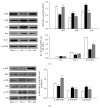Allopurinol Protects against Ischemia/Reperfusion-Induced Injury in Rat Urinary Bladders
- PMID: 26491537
- PMCID: PMC4600567
- DOI: 10.1155/2015/906787
Allopurinol Protects against Ischemia/Reperfusion-Induced Injury in Rat Urinary Bladders
Abstract
Bladder ischemia-reperfusion (I/R) injury results in the generation of reactive oxygen species (ROS) and markedly elevates the risk of lower urinary tract symptoms (LUTS). Allopurinol is an inhibitor of xanthine oxidase (XO) and thus can serve as an antioxidant that reduces oxidative stress. Here, a rat model was used to assess the ability of allopurinol treatment to ameliorate the deleterious effects of urinary bladder I/R injury. I/R injury reduced the in vitro contractile responses of longitudinal bladder strips, elevated XO activity in the plasma and bladder tissue, increased the bladder levels of tumor necrosis factor-α (TNF-α), c-Jun N-terminal kinase (JNK), and p38 mitogen-activated protein kinase, reduced the bladder levels of extracellular regulated kinase (ERK), and decreased and increased the bladder levels of Bcl-2 and Bax, respectively. I/R injury also elevated lipid peroxidation in the bladder. Allopurinol treatment in the I/R injury was generated significantly ameliorating all I/R-induced changes. Moreover, an in situ fluorohistological approach also showed that allopurinol reduces the generation of intracellular superoxides enlarged by I/R injury. Together, the beneficial effects of allopurinol reducing ROS production may be mediated by normalizing the activity of the ERK, JNK, and Bax/Bcl-2 pathways and by controlling TNF-α expression.
Figures






References
-
- Pinggera G.-M., Mitterberger M., Steiner E., et al. Association of lower urinary tract symptoms and chronic ischaemia of the lower urinary tract in elderly women and men: assessment using colour Doppler ultrasonography. BJU International. 2008;102(4):470–474. doi: 10.1111/j.1464-410x.2008.07587.x. - DOI - PubMed
Publication types
MeSH terms
Substances
LinkOut - more resources
Full Text Sources
Other Literature Sources
Research Materials
Miscellaneous

